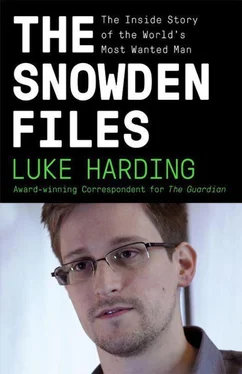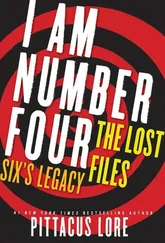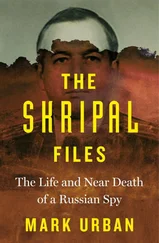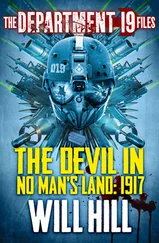His start date, Monday 3 June 2013, turned out to be exceptionally fortuitous.
Ackerman reported to the sixth floor at 536 Broadway. Compared to, say, the New York Times , the Guardian US’s SoHo office is small and low-key – an open-plan room shaped like an inverted L; with some computers, meeting areas and a kitchen containing PG Tips tea, biscuits and a coffee machine. On the wall are black and white portraits by the world-famous Observer photographer, Jane Bown. A picture of a young Rupert Murdoch also once hung in the editor’s office; the ironic Rupe was later to disappear to make way for framed Guardian front pages of its NSA scoops.
Below is the hubbub of Broadway: boutiques, cafes, tourists. Five minutes’ walk away down Spring Street is Mother’s Ruin, a favoured bar, with a stuccoed cream-coloured ceiling.
Guardian US is, perhaps, a vision of how media might look once print newspapers have gone the way of the dinosaurs. It is an exclusively digital operation, run with 31 editorial staff and a shoestring $5 million budget. (The NYT , by contrast, has 1,150 news-department employees.) About half of its journalists are Americans, mostly young and digitally native. Many have half-sleeve tattoos, one bold soul the full arm. The mission, as Gibson puts it, is to be an entirely US version of the London Guardian , offering a dissenting voice about the world.
Since its July 2011 start-up, the US audience had grown. Even so, the Brit interlopers seemed way too low down the Washington food chain to compete with news giants like the NYT , the Post or the Wall Street Journal . (The in-house joke was that at the annual 2012 White House press dinner, Guardian US had been allocated just two tickets, next to the toilets and the dumb waiter.)
As the week’s events would dramatically illustrate, not being part of the Washington club had its advantages. Gibson put it frankly: ‘Nobody takes our calls anyway. So we have literally nothing to lose in terms of access.’
The Guardian was the third-largest newspaper website in the world, well before Edward Snowden came along. But seemingly the White House had little idea what the title was – a newspaper, a free sheet, a blog? – or about the nature of its innovative British editor, Janine Gibson.
Ackerman never got the ‘orientation’ Gibson promised him. He watched for several hours as Gibson and her Scottish deputy Stuart Millar sat closeted inside her office. The door remained firmly closed. Occasionally she would emerge, heading briskly across the newsroom, before vanishing again behind frosted glass. As Millar, a 41-year-old who moved from London to NYC in 2011, put it: ‘Every time we came out to go to the bathroom or get a glass of water it was like meerkats popping up at desks, nodding to each other and sending out alarm signals.’ Clearly a big story was in the offing.
At lunch, Gibson finally asked Ackerman to join her and Millar: the three walked round the corner to Ed’s Lobster Bar in Lafayette Street. The restaurant was full; the three jammed up against other diners and ordered lobster rolls. Ackerman launched into chit-chat, only for the two Brits to cut him off. The editor then dropped her bombshell. She told him: ‘There is no orientation. We’ve got a good story that we need you to be involved in.’ Gibson laid out what was really going on – a whistleblower, in an unidentified third country. The whistleblower was working with Greenwald and MacAskill. They were preparing stories on… NSA surveillance. Holy shit!
Ackerman was stunned. ‘I went silent for a little while,’ he says. He adds: ‘I had been reporting on this stuff, on warrantless surveillance programs, for seven years. I got so deep into the weeds on this.’
Gibson briefed him on the PRISM slides, and the secret court order compelling Verizon to hand over the phone records of all of its US customers. Ackerman grasped his head in his hands and began rocking up and down, muttering, ‘Oh fuck! Oh fuck!’ before recovering his composure.
He was excited that his long-held suspicions were correct: the Obama administration was secretly continuing and even expanding Bush-era surveillance practices. Ackerman asked Gibson if the words STELLAR WIND meant anything to her. It did. ‘Birds sang. Butterflies fluttered,’ he recalls dreamily. ‘It was everything I had been trying to find for seven years.’ He went on: ‘I thought this white whale was coming to the tip of my harpoon. It turned out there was a pod of stories.’
The implications were massive. The Verizon secret court order was dated 25 April 2013. It forced one of the US’s largest telecoms providers to hand over to the NSA the telephone records of millions of its US customers. Verizon was passing on private details on an ‘ongoing, daily basis’. It was giving the NSA information on all calls in its systems, both inside the US and between the US and other countries. It was sensational apparent proof that the NSA was a dragnet collecting the records of millions of US citizens, regardless of whether they had committed any crime or been involved in terrorism.
The document was from the Foreign Intelligence Surveillance Act [FISA] court. Signed by Judge Roger Vinson, it gave the US administration unlimited authority to suck up telephone metadata for a 90-day period. The period ended on 19 July. ‘It was the most exciting thing I have ever seen. No one who is not authorised has seen a FISA court order,’ Ackerman says. ‘In my most fevered and conspiratorial imaginings I didn’t think they [the government] would be doing something like this.’ Was the three-month request a one-off? Were there other similar orders? There was no answer to that. Snowden had provided one recent document. But the suspicion was that the NSA compelled other major mobile phone networks to share their data in the same way.
At the New York office, Gibson drew up a careful plan. It had three basic components: seek legal advice; work out a strategy for approaching the White House; get draft copy from the reporters in Hong Kong. The NSA seemed so far unaware of the tsunami about to engulf it. Ironically, the Guardian was itself beginning to operate like a classic intelligence agency – working in secrecy, with compartmentalised cells and furtive encrypted communications. Email and conversations on open lines were out. Gibson wrote a tentative schedule on a whiteboard. (It was later titled ‘The Legend of the Phoenix’, in foot-tapping homage to the summer’s hit by the French electro duo Daft Punk.)
Those with knowledge of the Snowden project were a tiny group, burrowing into the heart of US secrecy. Newspaper people are, by their natures, incorrigible gossips. On this occasion all information was as tightly controlled as in a Leninist cell. Most staff were quite unaware their colleagues were strapping into a journalistic roller-coaster.
The paper intended to publish the Verizon story first. Of all the thousands of documents, these were the most comprehensible. ‘It was unequivocal, crystal-clear,’ Millar says. Next would come a story about the internet project codenamed PRISM. Then the revelation that the US was actively engaged in cyber-warfare. Last, if the paper made it that far, the truth behind a covername, BOUNDLESS INFORMANT.
The task was made fraught by the fact that the journalists working on the scoop were strung across the world – in Hong Kong, in the US, in Britain. Ackerman was sent back to Washington DC. He was told to get ready to contact Verizon. And, when the moment came, to liaise with the White House. In London, Alan Rusbridger, the Guardian ’s editor-in-chief, headed for the airport with diplomatic editor Julian Borger, for the next available New York flight.
Читать дальше












